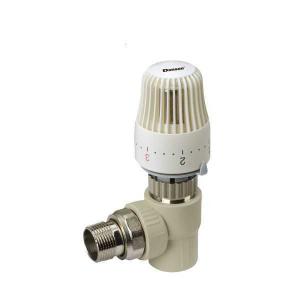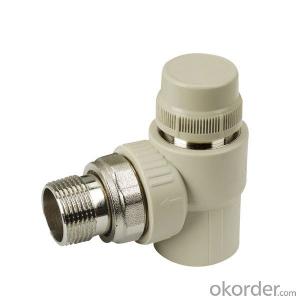Plastic Pipe Fitting PPR Elbow Stop Valve with Temperature Control
- Loading Port:
- Ningbo
- Payment Terms:
- TT OR LC
- Min Order Qty:
- 1000 pc
- Supply Capability:
- 100000 pc/month
OKorder Service Pledge
OKorder Financial Service
You Might Also Like
Specification




Specifications:
HYOSUNG PPR raw materials
Standard DIN8077-8078
GB/T18742.3-2002 PN25
White grey green color
Product Applications:
Distribution for cool and hot water
Duct for drinkable water system
Pipes for kinds of high-temperature and low-temperature heating system
Pipes for heating and coolling settings in solar energy system
Connecting pipe for air conditioners
Product Advantages:
1) Healthy, bacteriological neutral, conforming to drinking water standards
2) Resistant to high temperatures, good impact strength
3) Convenient and reliable installation, low construction expenses
4) Excellent heat-insulation property from minimum thermal conductivity
5) Lightweight, convenient to transport and handle, good for labor-saving.
6) Smooth inner walls reduce pressure loss and increase flow speed
7) Sound insulation (reduced by 40% compared to galvanized steel pipes)
8) Light colors and excellent design ensure suitability for both exposed and hidden installation
9) Recyclable, environment-friendly, accords with GBM standards
Main Product Features:
Large drum hub to maximize cable life
Self-activating automatic brake hold the load securely when crank handle is released
With cable or strap
Safety guard cover available
Top quality with competitive price
Widely used in the double beam bridge crane and gantry crane
Easy to install and high quality
Compact structure and reasonable design
Could be mounted on t he ground or wall!
Double drum!!
FAQ:
Q1:How Can I Get A Sample?
A1:You can get samples by communicate with our export sales.
Q2:How Long Is Delivery?
A2:Delivery time will be30-45days according to order quantity.
Q3:What Is The MOQ?
A3:MOQ depends on different items.
Q4:What Is Our Normal Payments Terms?
A4:Our normal payment terms now is: T/T, L/C or western union,paypal
- Q: Are plastic pipe fittings cost-effective?
- Yes, plastic pipe fittings are generally considered to be cost-effective. Plastic fittings are often more affordable than their metal counterparts and offer a good balance between cost and performance. Additionally, plastic fittings are lightweight, easy to install, and require minimal maintenance, which can further contribute to their overall cost-effectiveness.
- Q: What are the common sizes of plastic pipe fittings?
- The common sizes of plastic pipe fittings vary depending on the type of pipe system being used. However, some commonly used sizes include ½ inch, ¾ inch, 1 inch, 1 ¼ inch, 1 ½ inch, and 2 inches.
- Q: Are plastic pipe fittings suitable for use in breweries and distilleries?
- Yes, plastic pipe fittings are suitable for use in breweries and distilleries. They are commonly used in these industries due to their excellent resistance to chemicals, corrosion, and temperature variations. Additionally, plastic pipe fittings are lightweight, easy to install, and cost-effective, making them a popular choice for various applications in breweries and distilleries.
- Q: Can plastic pipe fittings be used for swimming pool plumbing systems?
- Yes, plastic pipe fittings can be used for swimming pool plumbing systems. Plastic fittings, such as PVC or CPVC, are commonly used in pool plumbing due to their durability, resistance to chemicals and corrosion, and ease of installation. These fittings are designed to withstand the water pressure and chemicals typically found in swimming pools, making them a suitable choice for pool plumbing systems.
- Q: How do you connect plastic pipe fittings to CPVC pipes?
- To connect plastic pipe fittings to CPVC pipes, you can use solvent cement specifically designed for CPVC. First, ensure that both the plastic pipe fittings and CPVC pipes are clean and free from any dirt or debris. Apply the CPVC solvent cement to both the fitting and pipe, making sure to coat the entire area that will be joined. Then, quickly insert the fitting into the CPVC pipe, giving it a slight twist to ensure a secure connection. Allow the solvent cement to dry as per the manufacturer's instructions before applying any pressure or using the connected pipes.
- Q: Can plastic pipe fittings be used for chemical storage tanks?
- No, plastic pipe fittings cannot be used for chemical storage tanks. Chemical storage tanks require specialized materials that are designed to withstand the corrosive nature of the chemicals being stored. Plastic pipe fittings may not have the necessary chemical resistance and structural integrity to safely contain and store chemicals.
- Q: Are plastic pipe fittings resistant to earthquake vibrations?
- Plastic pipe fittings can offer some level of resistance to earthquake vibrations, but it ultimately depends on the specific material and design of the fittings. Certain types of plastic pipe fittings, such as those made from high-density polyethylene (HDPE), are known for their flexibility and ability to absorb vibrations. However, it is important to note that no material is completely immune to the effects of earthquakes, and the overall resilience of a plumbing system also relies on proper installation and reinforcement techniques.
- Q: As long as the quality of plastic pipe is good Can the problem of plastic pipe connection be neglected?
- No details can be ignored; a small trachoma can cause heavy rework, especially in the hidden parts of the project, with more attention to detail,
- Q: Can plastic pipe fittings be used in industrial settings?
- Yes, plastic pipe fittings can be used in industrial settings. Plastic fittings are often chosen for their corrosion resistance, lightweight nature, and ease of installation. They can be suitable for a wide range of industrial applications, including water and wastewater treatment, chemical processing, and manufacturing processes. However, the specific requirements of the industrial setting, such as pressure, temperature, and chemical compatibility, should be considered when selecting the appropriate plastic fittings to ensure their suitability for the specific application.
- Q: How do you prevent leaks in plastic pipe fittings?
- To prevent leaks in plastic pipe fittings, it is essential to follow a few key steps. Firstly, ensure that the pipe ends are clean and free from any dirt or debris. Next, use proper tools to tighten the fittings securely, avoiding over-tightening which may damage the threads. Applying a suitable sealant or thread tape to the male threads can also help create a watertight seal. Finally, regularly inspect the fittings for any signs of wear or damage, and promptly replace any faulty components to prevent leaks from occurring.
Send your message to us
Plastic Pipe Fitting PPR Elbow Stop Valve with Temperature Control
- Loading Port:
- Ningbo
- Payment Terms:
- TT OR LC
- Min Order Qty:
- 1000 pc
- Supply Capability:
- 100000 pc/month
OKorder Service Pledge
OKorder Financial Service
Similar products
Hot products
Hot Searches
Related keywords






























